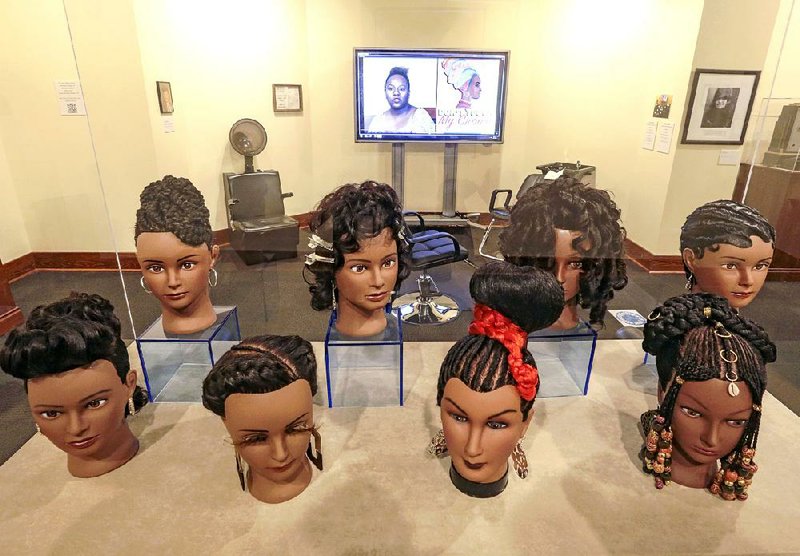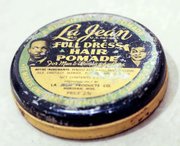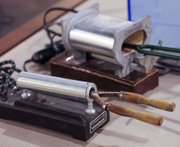The hoary head is a crown of glory, if it be found in the way of righteousness.
-- Proverbs 16:31, Old Testament
Museum Exhibit “Don’t Touch My Crown”
Through Aug. 31, Mosaic Templars Cultural Center, 501 W. Ninth St., Little Rock
Admission: Free
(501) 683-3593
Don't touch my hair
When it's the feelings I wear
Don't touch my soul
When it's the rhythm I know
Don't touch my crown
They say the vision I've found
Don't touch what's there
When it's the feelings I wear
-- From "Don't Touch My Hair"
by Solange Knowles
The glass wall art of a little girl getting her hair hot-combed is "probably" Christina Shutt's favorite in Mosaic Templars Cultural Center's current temporary exhibit, "Don't Touch My Crown."
The work takes Shutt, museum director, back to her earliest hair memory: her grandmother thermally straightening her hair, via pressing comb, on Saturdays. "And [me] sitting there shaking" because of fear of being burned by the hot comb, she says.
Nowadays, Shutt, who says she's had just about every hairstyle known to man -- "Wigs, I mean everything" -- believes black people are "still very much in the era of that DIY (do-it-yourself) attitude about a whole lot of things ... including and especially hair.
"It's no surprise that people are doing their hair at home and they're kind of trying to figure out how to love their own locks, so to speak."
Hair, which "has become symbolic of African Americans' struggle to define who they are in corporate America, society and in their own culture," is front and center in "Don't Touch My Crown." The exhibit opened June 14 and runs through Aug. 31 at the black-history museum.
The issue of black people treating their hair in such ways as to separate themselves from slavery, keep themselves from being seen as just out of the plantation fields and be considered "white" in terms of acceptability, is "Part One" of the social and cultural theme running through the exhibit. "Part Two" delves into the current issue of embracing one's hair in its natural state -- but, in light of lingering opinions of the look being unprofessional in workplace settings, asks the question: At what continuing cost?
Items in the exhibit include hair-salon furniture; hair-care products -- vintage and modern; hairstyling tools, including some old-school hot combs and curling irons; and an electrotherapy machine for the scalp and hair patented by William Meyer in 1925.
Also shown is wall art bearing hair themes. Visitors are educated on how, among members of the post-slavery black community, "light" skin and "good" hair were desired and even required, for acceptance and prosperity. Viewers also get a mini-lesson on cultural appropriation, with a reference to white actress Bo Derek and the beaded cornrows, dubbed "Bo braids," she wore in the 1979 movie 10.
The idea for an exhibit on hair was sparked a couple of years ago and gained momentum thanks to a joint exhibit between Mosaic Templars and the Esse Purse Museum, Shutt says. That exhibit, "Reflections: Images and Objects from African American Women, 1891-1987," ran Jan. 31-April 30, 2017.
"I was standing there, like, in the exhibit at the edge of the door," Shutt recalls. "And we had a small kind of pressing iron with a little oven. And every black woman that came through there had some story about getting her hair pressed. That was the point where I knew we had ... more than just an idea."
Museum officials began to meet and plan. One staff member initiated a meeting with Stephanie Sims, who wrote her master's thesis on the history of black hair. She became guest curator of the exhibit.
HAIR TODAY, HAIR TOMORROW
Sims says her thesis, "It's Growing on Them: Black Hair's Fight for Social Acceptance," was brought about by her consideration of how she and her classmates would style their hair as they went out and tried to get jobs. She thought it would be a great way to educate nonblack people on black hair, as well as an opportunity to show people trying to decide how to wear their hair that they can do whatever they wanted ... after all, Sims points out, "your hair does not identify you. It's an accessory."
Sims also felt that a look into black-hair issues shouldn't end with the 2009 documentary Good Hair, made by comedian Chris Rock and brought about when his daughter came to him, asking him why she didn't have "good hair" -- the more straight, less tightly curled hair traditionally perceived among black people as desirable. Sims lauds the movie, but at the same time, says it "kind of felt like we were being ridiculed" because it emphasized how many black women spend a lot of money on their hair, but failed to go into the reasons why they did it.
"I felt like he [Rock] could have focused more on why women ... go to certain extents to do those things," Sims says.
"Don't Touch My Crown" does its part to provide more to the story. In gathering artifacts for the exhibit, officials turned to Henri Linton of the University Museum and Cultural Center at the University of Arkansas at Pine Bluff "because he has collections of all sorts of things," Shutt says. "He loaned us some things for the exhibit."
Quantia Fletcher, assistant director at Mosaic Templars, drew on her relationship with Barbara Douglas, chief executive officer of Little Rock's nearly century-old Velvatex College of Beauty Culture. Initially they approached Douglas with an idea of seeing if they had some items or old school photos they could put in the exhibit. "And as we got to talking more, we developed some more programming around the exhibit," Shutt says, and the school went on to become a presenting sponsor. Trammell's Beauty and Barber Supply Inc. in Pine Bluff also provided items for the exhibit.
HONOR WHERE HONOR IS DUE
Reaction to "Don't Touch My Crown" has been "overwhelmingly positive," according to Shutt.
"Black women ... are the most disrespected women in America, historically. And so for this exhibit to be able to honor black women in particular in this way, and to talk about the struggles that we face, and deal with ... with our hair and with society's feelings about our hair, I think it's been really cool."
The title of the exhibit comes from Proverbs 16:31 in the Old Testament of the Bible, referring to the "hoary head" (one covered with grayish-white hair) as a crown. This idea of adding the "don't touch" component comes from "helping people understand that while our hair is beautiful and it's complex and all these wonderful things, we also don't want people to touch it," Shutt says.
"People don't even ask. They just touch your hair. [They don't realize] how frustrating that is and how dehumanizing that is. And again, we're thinking about how do we really honor black women who are often marginalized, whose hair, whose bodies are often victimized."
But she adds, those from other walks of life have related to the exhibit.
"Everybody has hair. And everybody has, sort of, crazy hair stories, going to the salon the first time, or getting a bad haircut, right?" She laughs. "It's been sort of that kind of unifying thing for a lot of people."
Interactive components include a video where people share their hair stories. The video plays in an area where beauty salon furniture has been placed -- "so you can sit in the styling chair and you can ... lean back in the wash bowl.
"But you'll notice that you don't ... touch any of the hair," Shutt adds, referring to a display of mannequin heads whose hair, thanks to Velvatex Beauty College students, reflect various styles that have been popular through the years. These heads are enclosed in a glass case so that, in keeping with the exhibit title, visitors could not touch the hair. "We want folks to understand that "don't touch my crown" [concept] and also to understand the professionalism that goes into [hair]styling."
IT'S ONLY NATURAL
Natural hair -- once seen by some black people as a negative stereotype as testified to by black actress Cicely Tyson, who was criticized for the cornrows she wore in the 1960s and '70s -- "is definitely more prominent in the media now," Sims says, what with more hair-care companies and product lines that cater to the natural hair movement, But, she adds, the issue of whether or not Afros, Afro puffs and twist-outs are acceptable in the board room remains.
It helps that a number of high-profile celebrities, such as Lupita Nyong'o, Taraji P. Henson and Tracee Ellis Ross have sported natural hairstyles, Sims says, also noting that Ursula Burns, former chief executive officer of Xerox, wears her hair like a "box fade," a natural low-cut Afro. These women give confirmation to others that they can wear their hair natural as well. So there has been some improvement, but the issue of acceptance versus nonacceptance "still tends to be a cycle that keeps repeating itself."
Black men who wear their hair in braids, cornrows and dreadlocks have an even bigger challenge, Sims believes. She cites celebrities who feel men who wear these styles look unprofessional, and a university business school that had all the men cut their braids and dreadlocks because "they felt like having their hair in that type of style would not lead them to a permanent position ... Sometimes people are still be characterized as being a criminal or mischievous because they have dreadlocks."
Both women believe that what goes around comes around in black hairstyle and hair-texture trends.
"I wouldn't be surprised if 20 years from now, people go back and decide relaxers are in style again," Shutt says. "But I hope, as people see the versatility of their own hair, that they'll really begin to embrace that, and to love their hair."
Sims repeats that she would like to see a day when identity is not tethered to hair.
"I think a lot of people have to understand that just because someone wears an Afro one day and then has 22-inch Malaysian hair the other, that they don't know who they are."
RELATED ARTICLES
http://www.arkansas…">Hair appreciation slow to take holdhttp://www.arkansas…">Don't Touch My Crown
Style on 07/10/2018




